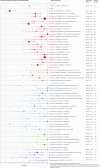No superior treatment for primary osteochondral defects of the talus
- PMID: 28656457
- PMCID: PMC6061466
- DOI: 10.1007/s00167-017-4616-5
No superior treatment for primary osteochondral defects of the talus
Abstract
Purpose: The purpose of this systematic literature review is to detect the most effective treatment option for primary talar osteochondral defects in adults.
Methods: A literature search was performed to identify studies published from January 1996 to February 2017 using PubMed (MEDLINE), EMBASE, CDSR, DARE, and CENTRAL. Two authors separately and independently screened the search results and conducted the quality assessment using the Newcastle-Ottawa Scale. Subsequently, success rates per separate study were calculated. Studies methodologically eligible for a simplified pooling method were combined.
Results: Fifty-two studies with 1236 primary talar osteochondral defects were included of which forty-one studies were retrospective and eleven prospective. Two randomised controlled trials (RCTs) were identified. Heterogeneity concerning methodological nature was observed, and there was variety in reported success rates. A simplified pooling method performed for eleven retrospective case series including 317 ankles in the bone marrow stimulation group yielded a success rate of 82% [CI 78-86%]. For seven retrospective case series investigating an osteochondral autograft transfer system or an osteoperiosteal cylinder graft insertion with in total 78 included ankles the pooled success rate was calculated to be 77% [CI 66-85%].
Conclusions: For primary talar osteochondral defects, none of the treatment options showed any superiority over others.
Level of evidence: IV.
Keywords: Ankle; Arthroscopy; Articular cartilage; Defect; Osteochondral lesion; Success rate; Systematic review; Talus.
Conflict of interest statement
Conflict of interest
The authors declare that they have no conflict of interest.
Funding
There is no funding source.
Ethical approval
This article does not contain any studies with human participants or animals performed by any of the authors.
Informed consent
Informed consent is not required for review articles.
Figures




Comment in
-
Comment on "No superior treatment for primary osteochondral defects of the talus. Dahmen J, et al. KSSTA 2017 Jun 27 PMID:28656457".Knee Surg Sports Traumatol Arthrosc. 2017 Dec;25(12):3982-3983. doi: 10.1007/s00167-017-4700-x. Epub 2017 Sep 4. Knee Surg Sports Traumatol Arthrosc. 2017. PMID: 28871367 No abstract available.
-
Reply to the letter to the editor: comment on "No superior treatment for primary osteochondral defects of the talus".Knee Surg Sports Traumatol Arthrosc. 2017 Dec;25(12):3984-3986. doi: 10.1007/s00167-017-4715-3. Epub 2017 Sep 16. Knee Surg Sports Traumatol Arthrosc. 2017. PMID: 28918432 No abstract available.
References
-
- Aaron RK, Wang S, Ciombor DM. Upregulation of basal TGFbeta1 levels by EMF coincident with chondrogenesis–implications for skeletal repair and tissue engineering. J Orthop Res. 2002;20:233–240. - PubMed
-
- Ahmad J, Jones K. Comparison of osteochondral autografts and allografts for treatment of recurrent or large talar osteochondral lesions. Foot Ankle Int. 2016;37:40–50. - PubMed
-
- Al-Shaikh RA, Chou LB, Mann JA, Dreeben SM, Prieskorn D. Autologous osteochondral grafting for talar cartilage defects. Foot Ankle Int. 2002;23:381–389. - PubMed
Publication types
MeSH terms
LinkOut - more resources
Full Text Sources
Other Literature Sources
Medical
Research Materials

